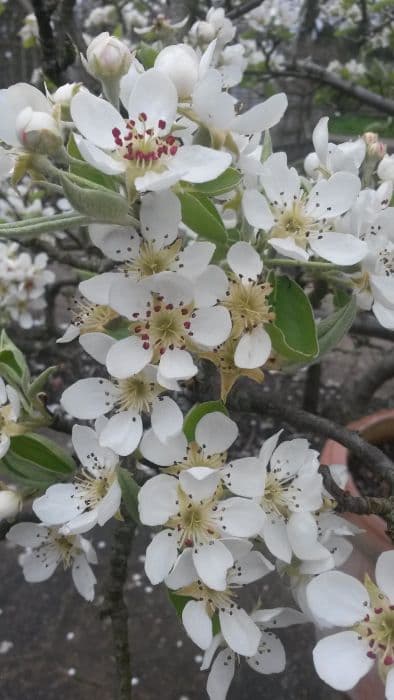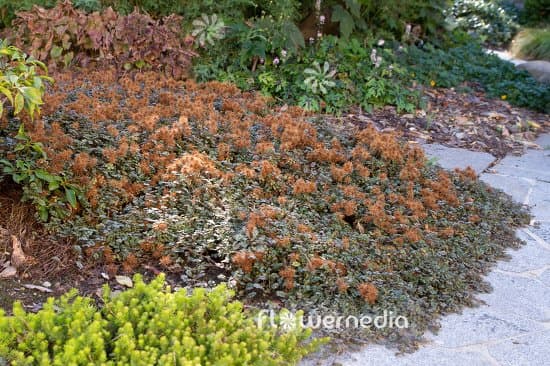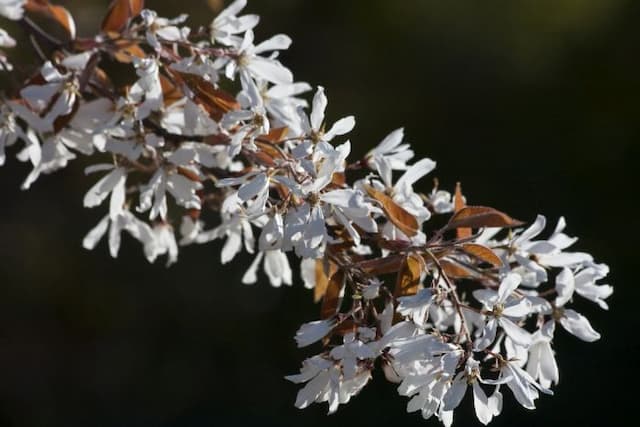Worcester Pear Pyrus communis 'Black Worcester' (C)

ABOUT
The 'Black Worcester' pear, a variety of the common pear, boasts striking features distinct to its cultivar. This plant is recognized for its fruit, which has a distinctive, almost round shape coupled with a rich, dark purplish-brown skin when ripe. The flesh inside is white, firm and quite dense, offering a sweet flavor with a hint of tartness, often described as rich and aromatic. It is important to note that the fruit's unusual color and historical significance make it quite a conversation piece in gardens where it is grown. The leaves of the 'Black Worcester' pear are distinctly broad and ovate with finely serrated margins, exuding a glossy, deep green hue that provides a lush backdrop for the fruit. The tree blooms with white flowers in clusters, known as corymbs, during the spring season. Each flower consists of five petals, which contribute to the ornamental value of the plant before the development of the notable fruit. These elements combined create an aesthetically pleasing appearance, with the dramatic contrast of the dark-hued fruit against the green foliage and white blossoms making this plant particularly attractive in a garden setting.
About this plant
 Names
NamesFamily
Rosaceae.
Synonyms
Black Worcester Pear, Worcester Black Pear.
Common names
Pyrus communis 'Black Worcester'
 Toxicity
ToxicityTo humans
The plant in question is commonly known as Pear. The Pear tree, including the 'Black Worcester' variety, is not considered toxic to humans. All parts of the Pear tree that are commonly consumed, such as the fruit, are safe to eat when ripe. There are no well-documented toxic effects from ingesting the ripe fruit of Pear trees in humans. However, eating the seeds in large quantities is inadvisable as they contain amygdalin, a compound that can release cyanide in the digestive tract. Accidental ingestion of small amounts of seeds is generally not harmful due to the low concentration of amygdalin, but consuming large quantities of seeds could potentially lead to symptoms of cyanide poisoning, which include headache, dizziness, confusion, difficulty breathing, and seizures in severe cases.
To pets
The Pear tree is also known by its common name, Pear. It is generally considered non-toxic to pets such as dogs and cats. The ripe fruit of Pear trees can be safely eaten by pets in moderation, although the seeds should be avoided. Similar to humans, the seeds contain amygdalin, which can lead to cyanide poisoning if ingested in large amounts. Signs of cyanide poisoning in pets may include vomiting, diarrhea, difficulty breathing, and potentially more severe symptoms such as seizures or collapse. It is always best to consult with a veterinarian if your pet consumes a large quantity of pear seeds or if there are any signs of illness following ingestion.
 Characteristics
CharacteristicsLife cycle
Perennials
Foliage type
Deciduous
Color of leaves
Green
Flower color
White
Height
12-20 feet (3.7-6.1 meters)
Spread
12-15 feet (3.7-4.6 meters)
Plant type
Tree
Hardiness zones
5-8
Native area
Europe
Benefits
 General Benefits
General Benefits- Ornamental value: The 'Black Worcester' pear, or common pear, adds aesthetic value to gardens and landscapes with its attractive shape and foliage.
- Fruit production: It produces edible fruits that can be used in cooking, baking, or eaten fresh when ripe.
- Shade provider: This pear tree can offer shade on sunny days, making it a practical addition to parks and large gardens.
- Wildlife support: The tree can provide food and habitat for wildlife, such as birds and beneficial insects.
- Seasonal interest: With seasonal changes in foliage color and blossoming flowers in spring, it adds year-round interest to outdoor spaces.
- Carbon sequestration: Like other trees, the common pear helps capture carbon dioxide from the atmosphere, contributing to the reduction of greenhouse gases.
 Medical Properties
Medical PropertiesThis plant is not used for medical purposes.
 Air-purifying Qualities
Air-purifying QualitiesThis plant is not specifically known for air purifying qualities.
 Other Uses
Other Uses- The Black Worcester pear's wood can be used in woodworking projects, particularly for creating intricate carvings or turnings because of its fine grain.
- The bark and leaves could be used in natural dye production, often giving a range of earthy tones.
- The dense wood of the Black Worcester pear can serve as a good fuel source for long-burning fires.
- Dried and ground, the leaves might be used as a natural additive to compost to enrich the soil with nutrients.
- Grafted branches can be used to propagate new pear trees, preserving this pear variety's genetic heritage.
- The dried fruit provides a unique natural decoration, which can be used in floral arrangements or seasonal displays.
- These pears can be used as artistic subjects due to their distinct shape and color, serving inspiration for painters and illustrators.
- Mature trees can act as a protective shelter for smaller plants in a garden, providing shade and windbreak capabilities.
- In historical reenactments or educational settings, this fruit can be used to illustrate the types of preserved foods from the Middle Ages onwards.
- As this is a very old variety of pear, it can be planted as part of heritage or conservation gardens, meant to preserve old and rare plant varieties.
Interesting Facts
 Feng Shui
Feng ShuiThe Pear Tree is not used in Feng Shui practice.
 Zodiac Sign Compitability
Zodiac Sign CompitabilityThe Pear Tree is not used in astrology practice.
 Plant Symbolism
Plant Symbolism- Longevity: Pear trees, including the 'Black Worcester', are known for their long lifespan, which often spans several generations. This longevity symbolizes the durability and continuity of life, heritage, and tradition.
- Fertility: Pears are often associated with fertility and abundance due to their fruitfulness. This symbology comes from ancient beliefs where fruits were seen as a sign of prosperity and a promise of future offspring.
- Peace: The pear tree has been a symbol of peace in various cultures. The fruit's gentle sweetness and the tree's graceful presence in gardens and orchards suggest a tranquil and harmonious existence.
- Affection: In some traditions, pears represent affection and warmth. Sharing a pear can be seen as an intimate act of friendship or love, highlighting the deep connections between individuals.
- Health and Healing: Historically, pears have been associated with health and wellness. The 'Black Worcester' and other pear varieties can symbolize the importance and value of health and the natural remedies provided by plants.
 Water
WaterThe European pear or common pear, specifically the 'Black Worcester' variety, requires deep watering to ensure the root zone is thoroughly soaked. Young trees should be watered once a week with about 2 gallons per session. Mature trees usually need water every 10 to 14 days during dry periods, with increased amounts ranging up to 10 gallons depending on the size of the tree and the weather conditions. Avoid overwatering, as pears do not like standing water. It is optimal to water early in the morning to reduce evaporation and allow the foliage to dry during the day.
 Light
LightThe 'Black Worcester' pear thrives in full sunlight for best growth and fruit production. Planting the tree in a spot that receives at least six hours of direct sunlight each day is ideal. Avoid locations with heavy shade or dappled light, as insufficient sunlight can lead to poor fruit yield and increased susceptibility to diseases.
 Temperature
Temperature'Black Worcester' pear trees are hardy and can tolerate a range of temperatures. They do well in areas where winter temperatures do not often drop below -20°F and summer temperatures average around 75°F to 85°F. The trees require a chilling period of cold temperatures to break dormancy and ensure healthy bud development, so a typical winter is beneficial for fruit set.
 Pruning
PruningPrune 'Black Worcester' pear trees to maintain their health, encourage fruit production, and shape the canopy. The best time for pruning is late winter or early spring before new growth starts. Thin out overcrowded branches and remove any damaged or diseased wood. Annual pruning helps to improve air circulation and light penetration into the canopy, which is essential for the development of quality fruit.
 Cleaning
CleaningAs needed
 Soil
SoilEuropean Pear 'Black Worcester' prefers well-draining, loamy soil with a pH between 6.0 and 7.0. A mix of garden soil, compost, and coarse sand or perlite is ideal to ensure proper drainage and fertility.
 Repotting
RepottingEuropean Pear 'Black Worcester' trees, being large fruit trees, are not typically grown in containers and thus do not need regular repotting.
 Humidity & Misting
Humidity & MistingEuropean Pear 'Black Worcester' is tolerant of a wide range of humidity levels, as it is grown outdoors and adapts to natural conditions.
 Suitable locations
Suitable locationsIndoor
Not suitable for indoor growth due to size.
Outdoor
Plant in full sun with ample space and well-drained soil.
Hardiness zone
4-8 USDA
 Life cycle
Life cyclePyrus communis 'Black Worcester', commonly known as the 'Worcester Pearmain' apple, begins its life cycle with seed germination in the early spring. Following germination, it enters a juvenile phase, growing into a sapling with leaves and establishing a root system. As it matures, the tree enters the vegetative stage, where it develops strong branches and foliage. This is followed by the flowering stage, typically in late spring, where the 'Worcester Pearmain' produces white flowers that are pollinated by insects, leading to fruit development. The fruit ripens in late summer to early fall, and once ripe, the apples can be harvested. After fruiting, the tree enters a dormant phase during the winter to conserve energy for the next growing season.
 Propogation
PropogationPropogation time
Early spring
Pyrus communis 'Black Worcester', commonly known as the 'Black Worcester' pear, is commonly propagated by grafting, which is the most popular method for this cultivar. This process involves taking a piece of a mature 'Black Worcester' pear tree, known as a scion, that contains buds and grafting it onto a rootstock of another pear variety. The best time to graft is in late winter or early spring when the trees are still dormant. Typically, a scion about 6 to 8 inches (15 to 20 cm) long is cut at an angle and joined to a similarly cut surface on the rootstock. The two pieces are then bound together, often with grafting tape or wax, to hold the joint secure until the scion has fully fused with the rootstock, a process that can take several weeks to months depending on environmental conditions. Grafting allows the 'Black Worcester' pear to benefit from the rootstock's hardiness and disease resistance while maintaining the desirable fruit characteristics of the 'Black Worcester' variety.

![Tree amelanchier [Tradition]](/_next/image?url=https%3A%2F%2Fplants-admin.emdemapps.com%2Fimages%2Fplants%2F%2Fimages%2F604b56afa99a2.png&w=640&q=75)




![Strawberry [Just Add Cream]](/_next/image?url=https%3A%2F%2Fplants-admin.emdemapps.com%2Fimages%2Fplants%2F%2Fimages%2F604b5f8e7d168.png&w=640&q=75)


